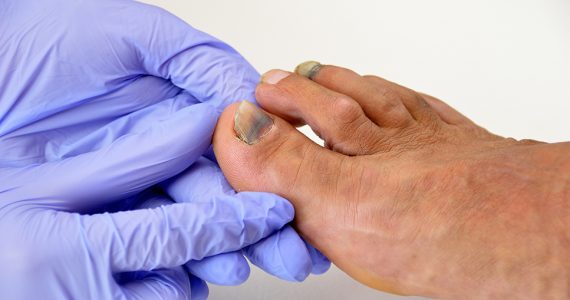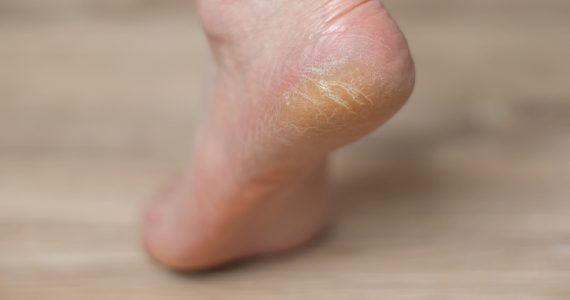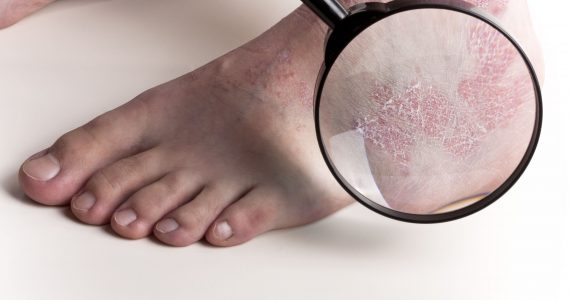
The most common pathologies affecting the nails are:
- ANONYCHIA
Anonychia is the absence of nails on the fingers or toes and can be either congenital (or more rarely linked to growth disorders) or acquired (as a result of psoriasis). This pathology may occur together with a variation in the natural colour of the nail (chromonychia). The cause of this alteration could be an intake of medications and/or the metabolism of toxic substances.
- HELOMA OR PERIUNGUAL CALLUS
Heloma is a thickening of the horny layer of the skin (hyperkeratotic callus plaques) that form in the spaces between the toes or around the edges of the nails.
- LEUKONYCHIA
Following infection due to pathogenic agents (yeasts, moulds or dermatophytes) the nail tends to lose its colour either partially or totally, or it acquires grooves or white lines lengthwise from the base to the free edge.
- WHITE SPOTS ON THE NAILS
In some cases, white spots on the nails are the result of air bubbles between the keratinocytes
- LONGITUDINAL MELANONYCHIA OR MELANONYCHIA STRIATA
Melanonychia is a dark pigmentation of the nail (brown or black) due to a build-up of melanin within the nail plate produced by a greater number of melanocytes than normal.
Causes of this pathology can be:
-
- infection by yeasts or moulds
- Median canaliform dystrophy of Heller: the nail plate is divided symmetrically by a central groove in the nail.
- ONYCHAUXIS
Onychauxis is a thickening of the nail associated with a brown-yellowish pigmentation of the nail plate and with hypertrophy of the furrows caused by a thickening of the nail edges.
- ONYCHOCRYPTOSIS (ingrown toenails)
A condition in which the nail plate penetrates deep into the skin creating inflammation and pain.
- ONYCHODYSTROPHY
This is an alteration in the nail structure in which the nail tends to break and/or split. Causes of this pathology can be:
-
- Insufficient blood flow to the matrix
- Malnutrition
- Aging
- Frequent traumas
- Infections
- ONYCHOPHOSIS
This is a build-up of hyperkeratosis in the lateral fold of the nail most commonly affecting the big toe. It is usually caused by:
-
- Pressure exerted by tight footwear or by the toe next to it
- Deformity or inadequate cutting of the nails
- ONYCHOGRYPHOSIS (claw nail)
This appears as a thickening of the nail as it grows until it resembles a claw. In this condition it is difficult to cut the nail because of its thickness; it can come with age, but can also be due to sports traumas.
- ONYCHOLYSIS
It is usually a precursor of nail psoriasis and usually appears as a detachment of the nail plate from the nail bed and a discolouration if a pathogenic agent is present; the lamellae can also lose their adherence and cause fractures.
Onycholysis can result from taking some medications or from repeated traumas (arising from sports or from footwear that is too tight).
- ONYCHOMYCOSIS
- ONYCHORRHEXIS
The nail becomes fragile and presents striations and vertical cuts. Onychorrhexis is typical of elderly people.
- ONYCHOSCHIZIA LAMELLINA (lamellar nail splitting)
The superficial layers of the nail plate peel away showing microfractures in the free edge and usually causing the nail plate to split.
- PACHYONYCHIA
This presents itself as a thickening, deformation and a greyish appearance of the nail plate due to the germinative hyperproliferation of the nail matrix. This condition can arise from:
-
- Aging
- Psoriasis or eczema
- Onychomycosis
- Hereditary pathologies: Jadassohn-Lewandowsky syndrome
Jadassohn Lewandowsky I Syndrome: A pathology of the ectoderm consisting of excessive thickening of the nails (from birth), blisters on the soles of the feet and palmoplantar hyperkeratosis. Because of a papillary atrophy, the tongue takes on a glazed appearance and verrucas and cysts can be seen on the epidermal layer.
- PERIONYXIS or PARONYCHIA
This is an inflammation of the paronychium (the soft tissue surrounding the nail plate). It most frequently affects the index finger and the middle finger and appears as a swelling and reddening around the nail. To prevent it, gloves should be worn when carrying out activities that involve prolonged contact with water or substances (glucides) that encourage mycoses. It can be the precursor to an infection of Candida, Staphylococcus or Herpes Simplex.
- “THIMBLE” NAIL
This condition appears as a dulling of the nails (similar to the effect of an abrasion) and is associated with alopecia areata.
- BLUE NAILS
Caused by taking medications such as tetracycline or chloroquine.
- CLUBBED NAILS (watch-glass nails)
Clubbed nails can be a sign of a problem in the respiratory system: lungs and bronchial tubes.
- GREEN NAILS
In general, this condition is caused by a Pseudomonas infection (small rod-shaped bacteria found in the soil and in water, it colonises the skin and airways of humans).
- XANTONYCHIA
This condition affects the surface of the nail, it typically appears as yellow staining or a yellowish discolouration. Xantonychia is widespread among smokers, individuals suffering from psoriasis, those with an over active thyroid, those who use medications (tetracycline) and users of nail varnishes or solvents that are too aggressive.



